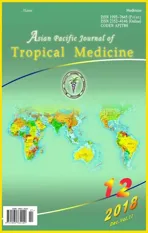Phytocompounds of Anonna muricata leaves extract and cytotoxic effects on breast cancer cells
2019-01-05HusnaSyakirahAbRahmanWanSuriyaniWanIbrahimNorzilaIsmailTuanNadrahNaimTuanIsmailSitiFarhanahMohdSallehMichaelPakKaiWongMohdRidzuanAbdulSamadMohdNizamMdHashim
Husna Syakirah Ab Rahman, Wan Suriyani Wan-Ibrahim, Norzila Ismail, Tuan Nadrah Naim Tuan Ismail, Siti Farhanah Mohd-Salleh, Michael Pak-Kai Wong, Mohd Ridzuan Abdul Samad, Mohd Nizam Md Hashim
1Department of Surgery, School of Medical Sciences, Universiti Sains Malaysia,16150 Kubang Kerian, Kelantan, Malaysia
2Department of Pharmacology, School of Medical Sciences, Universiti Sains Malaysia,16150 Kubang Kerian, Kelantan, Malaysia
3School of Dental Sciences, Universiti Sains Malaysia,16150 Kubang Kerian, Kelantan, Malaysia
Keywords:Annona muricata GCMS Anti-proliferative Breast cancer Graviola
ABSTRACT Objective: To identify the phytochemical compounds from Annona muricata (A. muricata)and to determine their in vitro anti-proliferative activities against breast cancer cells, MCF7 and MDA-MB-231. Methods: A. muricata leaves were successively extracted by soxhlet method using n-hexane, ethyl acetate and methanol, and decocted with water. Each extract was analysed by gas chromatography mass spectrometry (GCMS) and characterized with Wiley and NIST library searches. Anti-proliferative activity of each extract was evaluated on MCF7 and MDA-MB-231 breast cancer cells using MTT assay. Results: The GCMS analysis of different solvent extracts of A. muricata leaves showed presence of different chemical groups of compounds such as steroids, terpenoids, phenolic compounds, sugars, sugars alcohol and others including vitamin E. Ethyl acetate leaves extract exhibited the lowest IC50 value on the MDA-MB-231 breast cancer cell and n-hexane leaves extract showed the the lowest IC50 value on the MCF-7 breast cancer cell. Conclusion: Steroids and phenolic compounds were the main phytocompound groups identified from all A. muricata leaves extracts. The antiproliferative activity of n-hexane and ethyl acetate extract towards breast cancer MCF7 and MDA-MB-231 respectively might be due to the presence of biologically active compounds in the extracts,hence, providing some scientific evidences of the effectiveness of its traditional usages.
1. Introduction
Medicinal plants have been used all over the world for the treatment and prevention of various ailments, particularly in developing countries where infectious diseases are endemic and modern health facilities and services are inadequate[1]. In the community whereby the conventional and alternative medicines are widely practised, many studies have been done to search for alternative treatments for cancer patients. Complementary medicine is favourable as most of the patients are fearful of the adverse effects of the conventional chemotherapy and radiotherapy[2]. The population has overlooked the fact that a lot of natural products have not been studied thoroughly with regards to its efficacy and safety profile. There are many natural products that are believed to have therapeutic properties[3], however, more studies are needed to exhibit these properties in a systematic and scientific manner in the era of evidence-based practice.
In Malaysia, Annona muricata (A. muricata) is a well-known plant that is believed to treat cancer traditionally. Some call it Graviola or Soursop but the locals know it as ‘Durian Belanda’ or ‘Durian Selat’.Many studies have been done on this plant worldwide due to its benefits in treating various ailments, especially cancer and parasitic infections. The fruit is commonly used to treat diarrhea, dysentery,fever, helminth infection and arthritis, while the leaves decoction is traditionally used to treat cancer, rheumatoid and neuralgia[4-9].
A. muricata leaves are claimed to have the best therapeutic activities while the fruits are mostly consumed as juice. In most cancer studies,the leaves were commonly extracted by maceration[10,11] either at room temperature[12] or in dark[13]. However, traditionally the locals obtained the extract by decoction of the leaves. The efficacy of the extract used might not only depend on a single compound, but possibly all the present compounds work synergistically. Compounds in extracts obtained via maceration would be different with the ones that are obtained using heating process, as different type of extraction methods have different strengths and limitations[14].
To date, gas chromatography mass spectrometry (GCMS) remains an important tool to identify compounds and their percentage in a complex mixture of crude extracts. GCMS analysis that has been done on ethanol[15,16] and methanol[17] leaves extract of A.muricata[18], identified a few types of acetogenins [muricatalicin(I), muricatalin (VI) and annonacin-B mesitoate (Vb)], which have potential antineoplastic activities. Our study was carried out to identify the compounds present in the A. muricata n-hexane-, ethyl acetate-, methanol-, and aqueous leaves extract by GCMS. These extracts were then used to study their anti-proliferative activities on breast cancer cell lines, MCF7 and MDA-MB-231.
2. Material and method
2.1. Plant materials
The leaves of A. muricata were imported from Indonesia in January 2016 and were authenticated by Dr. Farah Alia Nordin, from the Herbarium Unit, School of Biological Sciences, Universiti Sains Malaysia. The voucher specimen (USM.Herbarium 11770) was submitted for future reference. The leaves were oven-dried at 40 ℃and ground to powder.
2.2. Plant extraction and extract preparation
A. muricata leaves were successively extracted using soxhlet apparatus[19-22]. A total of 55 g of A. muricata powdered leaves were first extracted with n-hexane until the solution turned colourless. The extract was then filtered and dried using rotatory evaporator. The residual extract was sequentially extracted with ethyl acetate and methanol. Water extract was prepared through decoction method: 55 g of A. muricata leaves were placed in a beaker and filled with 500 mL of distilled water. The decoction of the leaves was done at 50 ℃ until the water was reduced to one-third of the initial volume and filtered with Whatman filter paper no. 1. The water extract was dried using freeze drier. All the extracts of A. muricata were kept at -20 ℃ until use.
2.3. GCMS
2.3.1. Sample preparation for GCMS
The dried extract (0.5 mg) was derivatised with 50 μL N-methyl-N-(trimethylsilyl) trifluoroacetamide (MSTFA) in a sealed glass tube for 30 min at 60 ℃. The trimethylsilylated extract was cooled to room temperature before diluting with 50 μL of dodecane. The extract was transferred into a crimped cap vial before GC-MS analysis. Blank solvent (n-hexane, ethyl acetate, methanol, and water) was dried and treated similarly as the sample.
2.3.2. GCMS conditions and parameters
GCMS was carried out using Hewlett Packard 6890 Gas Chromatograph fitted with 5973N Mass Selective Detector. The column used was fused silica capillary, HP-5 column (30 m × 0.25 mm i.d × 0.25 μm film thickness) (Agilent Technologies, USA).The carrier gas was helium with flow rate at 1.0 mL/min with the oven temperature being programmed from 50 ℃(held for 2 min) to 280 ℃(held for 10 min) at a rate of 10 ℃/min. The injection and interface temperatures were set at 250 ℃ and 280 ℃, respectively.One microliter sample was injected in splitless mode and analysed in MS full scan mode (m/z 40-650). The electron ionization was set at 70 eV. Acquisition of data was performed using Chemsation software.
2.3.3. Identification of the chemical constituents
The library of mass spectra was used to match and identify an unknown chemical in the sample mixture. The mass spectrum produced by a certain chemical compound is basically the same every time. Therefore, the mass spectrum is essentially a fingerprint for the molecule. This fingerprint can be used to identify the compound.The phytocompounds were identified by library searching Wiley 275 and National Institute of Standards and Technology (NIST 02) mass spectral databases. The percentage compound was calculated from the summation of the peak areas of the phytocompounds.
2.4. Cell culture
The MCF7 and MDA-MB-231 cells were cultured in Dulbecco’s modified Eagle’s medium (DMEM, Gibco), supplemented with 10% of fetal bovine serum (FBS, Gibco), 100 μg/mL penicillin and 100 μg/mL streptomycin (Gibco). The cells were maintained at 37 ℃ and 5% CO2in a humidified atmosphere CO2incubator.
2.5. Anti-proliferative assay
MCF7 and MDA-MB-231 cell were cultured until the culture media reached 70% to 80 % confluence. The cells were trypsinized(0.25% Trypsin/1 mM EDTA, Gibco) and seeded in 96 well cell culture plates at a density of (5 × 104) cells/mL for 24 h. Then, the cells were treated with each of A. muricata leaves extracts in the final concentration of 0 to 100 μg/mL. Control cells were incubated with tamoxifen as a positive control and dimethyl sulfoxide (DMSO) as a negative control. After 72 h incubation, the 3-(4,5-dimethylthiazol-2-yl)-2,5 diphenyl tetrazolium bromide (MTT) assay was performed to determine anti-proliferative activity of MCF7 and MDA-MB-231 cell culture after treated with A. muricata leaves extracts. A total of 50 μL of 0.25 mg/mL MTT solution (Merck, Germany) was added into each well. After 4 h incubation, the MTT solutions were discarded and DMSO was added to dissolve the formazon crystals. The absorbance of the solution was measured at 570 nm wavelength. Percentage of the cell viability was calculated by dividing the number of cells(treated with extract) with the number of cells (treated with DMSO),times 100. Three independent experiments were performed and mean of the cell viability was recorded. The IC50values (the concentration that inhibit 50% of cell viability) for each extracts were determined by using the mean of the cell viability, to evaluate the anticancer activity of A. muricata leaves extracts.
2.6. Statistical analysis
All value were expressed as the mean±S.E.M. Statistical analysis were evaluated by Students’s t-test. Probability values P<0.05 were considered statistically significant.
3. Results
3.1. GCMS analysis
Results of GCMS analysis of different solvent extracts of A.muricata leaves were shown in Table 1-4. The chromatograms of all extract are in Figure 1 (A–D). The chemical compounds of each solvent and aqueous extracts were different due to the different polarity of the solvents and water. Eight phytocompounds were identified from the hexanoic leaves extract, which consist of steroids,cyclitol, terpenoids and others. Our result showed that β-sitosterol was the main compound in this extract and interestingly, it was identified for the first time in A. muricata leaves (Table 1).
Phytochemical compounds identified from the ethyl acetate extract of A. muricata were steroids, phenolic compounds, sugar alcohol,sugar and others. Phenolic content from the ethyl acetate extract of A. muricata leaves was the highest (2.55%) (Table 2).
The methanol and aqueous extract of A. muricata leaves were found to exhibit better efficiency in extracting various polar chemical compounds such as phenolic compounds, amino acids, sugar, sugar alcohol and sugar acids. Sugars were the main compound identified in methanol (13.01%) and aqueous (13.61%) leaves extract of A.muricata (Table 3, 4).
3.2. Anti-proliferation assay
All extracts were subjected to anti-proliferative assay via MTT on both MDA-MB-231 and MCF7 cell lines. Figure 2 showed that the numbers of viable MDA-MB-231 cells after treatment with each extract of A. muricata. The best extract was ethyl acetate followed by methanol, water, and n-hexane. Figure 3 showed that there were significant reductions in the number of MCF7 cells after treated with each extracts of A. muricata. The IC50values for each A. muricata extract for MDA-MB-231 and MCF7 cell lines were summarized in Table 5. Our results demonstrated that ethyl acetate extract has the lowest IC50value for MDA-MB-231 at 15.0 μg/mL while the n-hexane extract exhibited the lowest IC50value for MCF7 cells at 13.0 μg/mL.
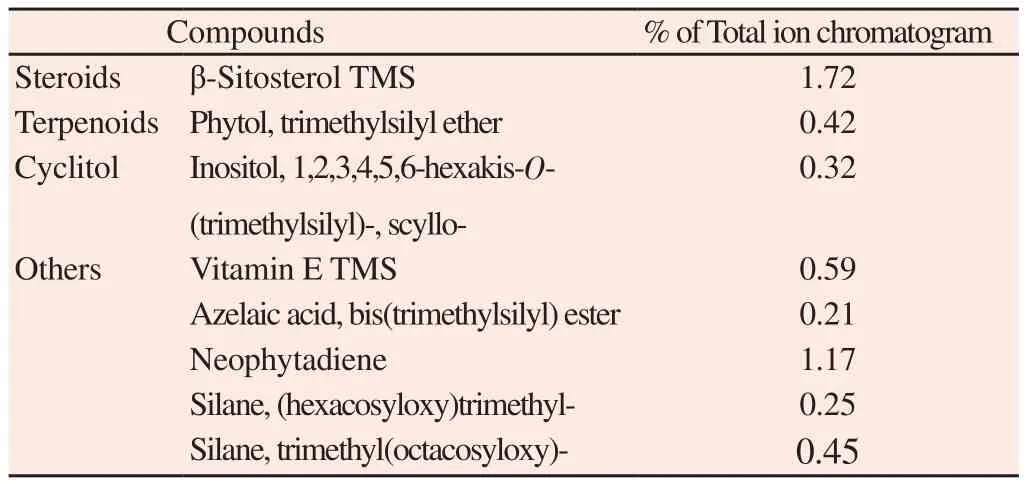
Table 1 GCMS for n-hexane extract of A. muricata.

Table 2 GCMS for ethyl acetate extract of A. muricata.
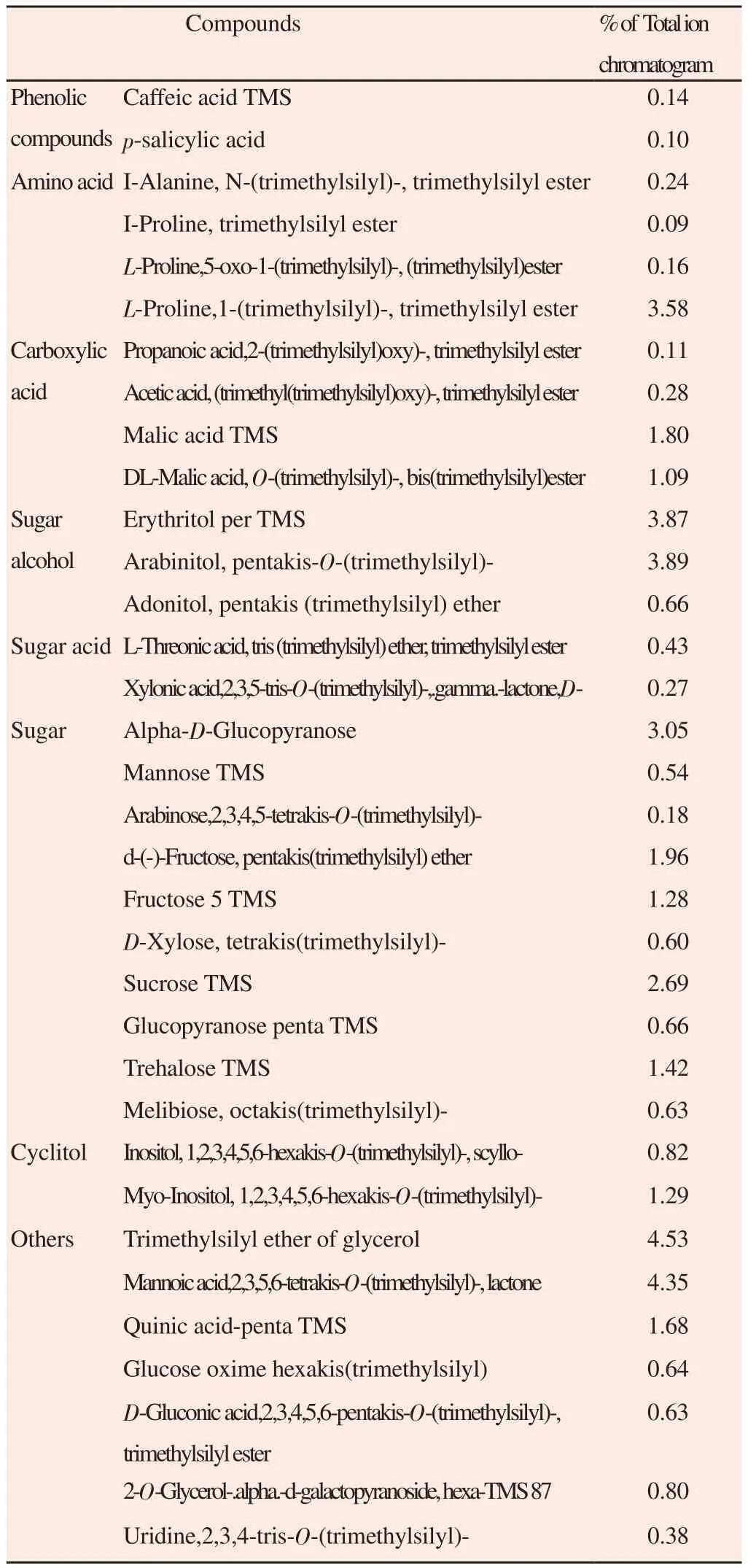
Table 3 GCMS for methanol extract of A. muricata.
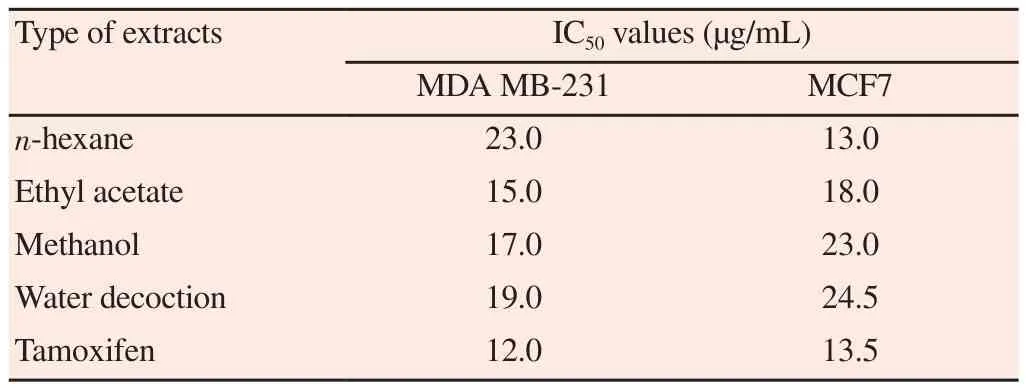
Table 5 IC50 values for each A. muricata extract for MDA-MB-231 and MCF7 cell lines.

Table 4 GCMS for aqueous extract of A. muricata.
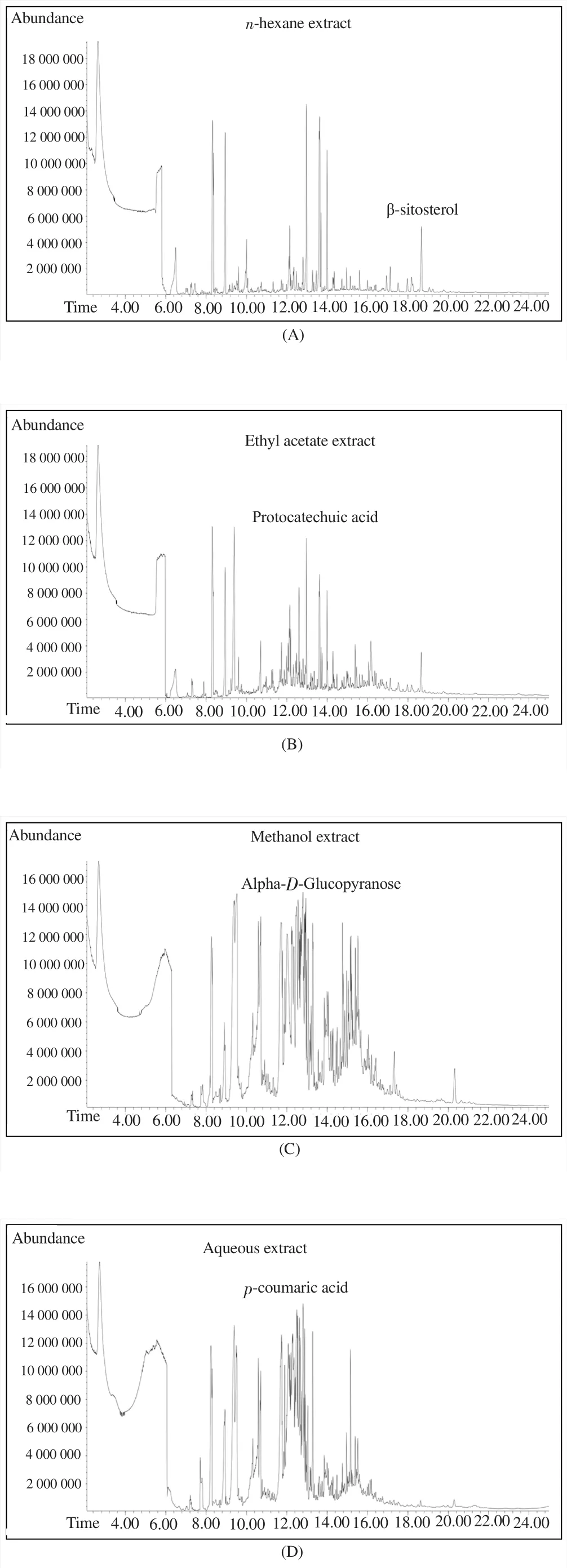
Figure 1. Total ion chromatogram for all extract (A) n-hexane, (B)thyl acetate, (C) methanol and (D) aqueous, of A. muricata leaves.

Figure 2. Percentage of viable MDA-MB-231cell after treatment with different extracts (n-hexane, ethyl acetate, methanol and water, and tamoxifen) at different concentration.)

Figure 3. Percentage of viable MCF7 cell after treatment of different concentration of different extracts (n-hexane, ethyl acetate, methanol and water, and tamoxifen).
4. Discussion
Different groups of chemical compounds such as steroids,terpenoids, phenolic compounds, sugars, sugars alcohol and others, including vitamin E were identified in the extracts of A.muricata leaves in our study. The phytochemical results shown are in agreement with the studies reported previously[4]. Steroids,terpenoids, and phenolic compounds are phytochemical groups that are known to have a wide range of biological activities including cytotoxic[23], antioxidant[24], and antimicrobial properties[25].
GC-MS analysis n-hexane extract of A. muricata leaves revealed the presence of steroids, terpenoids and other compounds. Steroids represented 1.72 % of the total n-hexane extract where β-sitosterol was the major compounds detected. Various studies have shown β-sitosterol isolated from plants has the ability to inhibit cancer cell development. β-sitosterol promotes apoptosis in methyl nitrosourea induced mammary gland carcinoma in rats[26], MDA-MB-231 human breast cancer cell lines[27], human leukemic U937 cells[28]and colon cancer[29]. Results from the MTT assay showed that n-hexane extract has the lowest IC50value for MCF7, and this could be contributed by the presence of β-sitosterol and phytol.
Phytol is a component of chlorophyll, which exhibits anticancer and immune-enhancing effects[30]. Phytol induced apoptosis through activation of caspase 9 and 3 in hepatocellular carcinoma cells[31] and lung carcinoma cell line A549[32]. Phytol augments the activity of natural killer cells to remove cancer cells and increase immunity by regulating macrophage function[30]. No phenolic compounds were identified in this extract as it was identified in a previous study[33]. Their extract was obtained by first macerating the ground leaves in methanol at room temperature for 24 h, filtered using Büchner funnel and evaporated. The dried extract was further dissolved in methanol and sonicated prior to mixing with n-hexane and followed by by chloroform in liquid-liquid portioning method.Different method applied during plant extraction process resulted in different phytocompounds obtained from each extraction.
Our data also showed the presence of vitamin E. Vitamin E has antioxidant property[34]. Recently it has been reported that Vitamin E exerted chemoprotective effect in cyclophosphamide-induced hepatotoxicity in rats[35]. Neophytadiene is a hydrocarbon in nature and is known to have antipyretic, analgesic, antiinflammatory,antimicrobial and antioxidant properties[36]. Azelaic acid is widely used in acne treatment and possesses diverse biological activities such as antiinflammatory, antioxidative effects and antibacterial[37,38].
In ethyl acetate extract, terpenoids were not identified. This is contrary to a previous study that showed ethyl acetate extract of A. muricata leaves were comprised of terpenoid (phytol), phenolic compound(Phenol, 4-ethenyl-, acetate) and vitamin E (tocopherol)[4]. This is because they used soaking sequential solvent extraction method as opposed to our sequential solvent extraction using soxhlet. The main compound identified from the ethyl acetate extract is the protocatechuic acid (PA). This is a natural phenolic compound which is also known as 3,4-dihydroxybenzoic acid and it can be found in many edible and medicinal plants[41]. In the study conducted by Moghadamtousi et al[4], 1,2,3-propanetriol, 1-acetate were the main compounds identified in the ethyl acetate leaves extract[4]. Results from the MTT assay showed that ethyl acetate extract had the lowest IC50value for MDA-MB-231, which could be related to the presence of PA.PA mechanism of action is related to the antioxidant activity which inhibit the generation of free radicals besides promoting the enzymes that are involved in their neutralization[39]. PA is a polyphenolic compound and in general, polyphenols has been found to inhibit tumor growth and induce apoptosis[40,41]. This compound has also been shown to have various types of other biological activities such as anti-inflammatory, antihyperglycemic and antibacterial[42].
Both methanol and aqueous leaves extract still exhibited a potent anti-proliferative effect on both cancer cells. Based on the guidelines set by the Americal National Institute, the activity limit for crude extract for IC50after 72 h of exposure is 30 μg/mL[43]. Based on a study by Gavamukulya[15] and co-workers, GCMS analysis of ethanolic extract of leaves of A. muricata contained 25 constituents,the major constituents were 7-tetradecenal, n-hexadecanoic acid, oleryl alcohol, phytol, cis,cis,cis-7,10,13-hexadecatrienal,2-pentadecanol, 9,12-Octadecadienoic acid, ethyl ester, 1,2-benzenedicarboxylic acid, butyl octyl ester, and 1,E-11,Z- 13-octadecatriene[44]. On the other hands, the main constituents found in methanol extract of the leaves are 4H-pyran-4- one, 2,3-dihydro-3,5-dihydroxy-6, tetradecanoic acid, 3,7,11,15-tetramethyl-2-hexadecen-1-ol, hexadecanoic acid methyl ester, n-hexadecanoic acid, phytol and octadecanoic acid[17]. Terpenoids were not identified in both extracts in our study and this is contrary to the previous studies that showed the presence of terpenoids in both methanol[17] and aqueous leaves extract of A. muricata[45]. This is because of the different methodology used in the plant extraction, where they used single 70% methanol extraction by soaking presumably[17], while in the aqueous extraction[45], the method used was soaking of 5 g of the powdered leaves for 12 h. In our study, terpenoids were only identified in the n-hexane leaves extract of A. muricata.
Although, all extracts have shown cytotoxic effect on both cancer cells, the best effect was seen in the n-hexane extract for MCF7 and ethyl acetate extract for MDA-MB-231 cells. Further analysis is needed in order to characterize which specific compound in the n-hexane- and ethyl acetate- leaves extracts that might contribute to the inhibition of the cancer cells.
This study showed that the n-hexane and ethyl acetate extracts of A.muricata leaves are most potent on both types of breast cancer cells,MDA-MB-231 and MCF7 respectively. The presence of biologically active compounds in the extracts provides some insight on the scientific evidences of the effectiveness of its traditional use.
Conflict of interest statement
The authors declare that there is no conflict of interest.
Foundation project
This study was funded by the Universiti Sains Malaysia Short Term Grant (304/PPSP/6313322).
杂志排行
Asian Pacific Journal of Tropical Medicine的其它文章
- Salacca zalacca: A short review of the palm botany, pharmacological uses and phytochemistry
- Immune enhancement effect of an herb complex extract through the activation of natural killer cells and the regulation of cytokine levels in a cyclophosphamide-induced immunosuppression rat model
- Screening of antiproliferative activity mediated through apoptosis pathway in human non-small lung cancer A-549 cells by active compounds present in medicinal plants
- Ultrasound-assisted extraction of antioxidant polyphenolic compounds from Nephelium lappaceum L. (Mexican variety) husk
- High resolution melting real-time PCR detect and identify filarial parasites in domestic cats
- Can miRNA712_3p be a promising biomarker for early diagnosis of toxoplasmosis?
